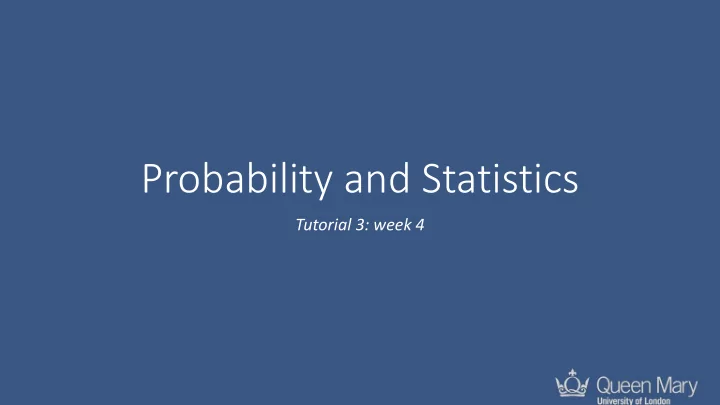

Probability and Statistics Tutorial 3: week 4
Problem 6A (𝐛) 𝑸 𝑼 𝟐 > 𝟒 𝒏𝒋𝒐𝒗𝒖𝒇𝒕 • 𝑈 1 ∼ 𝐹𝑦𝑞 0.2 ANSWER: • Use the cumulative distribution for 𝑈 1 : 𝐺(𝒖) • 𝑈 2 ~ 𝐹𝑦𝑞 0.25 • 𝑄 𝑈 1 > 3 = 1 − 𝑄(𝑼 𝟐 ≤ 𝟒) = 1 – 𝐺(3) • 𝑈 1 𝑏𝑜𝑒 𝑈 2 𝑏𝑠𝑓 𝑗𝑜𝑒𝑓𝑞𝑓𝑜𝑒𝑓𝑜𝑢 • Analytically: 𝐺 𝑢 = 1 − 𝑓 −𝜇𝑦 = 1 − 1 − 𝑓 −0.2×3 = 0.54881 R code: 1 – pexp(t,rate) 1- pexp(3,0.2)
Problem 6B (𝐜) 𝑸 𝑼 𝟑 < 𝟓 𝒏𝒋𝒐𝒗𝒖𝒇𝒕 • 𝑈 1 ∼ 𝐹𝑦𝑞 0.2 ANSWER: • Use the cumulative distribution for 𝑈 1 : 𝐺(𝒖) • 𝑈 2 ~ 𝐹𝑦𝑞 0.25 • 𝑄 𝑈 2 < 4 = 𝑄(𝑈 2 ≤ 𝟓) = 1 – 𝐺(4) • 𝑈 1 𝑏𝑜𝑒 𝑈 2 𝑏𝑠𝑓 𝑗𝑜𝑒𝑓𝑞𝑓𝑜𝑒𝑓𝑜𝑢 (WHY?) • Analytically: 𝐺 𝑢 = 1 − 𝑓 −𝜇 2 𝑦 = 1 − 𝑓 −0.25×4 = 0.632 R code: pexp(t,rate) pexp(4,rate = 0.25)
Normal Distribution 𝑼𝒊𝒇 𝑶𝒑𝒔𝒏𝒃𝒎 𝑬𝒋𝒕𝒖𝒔𝒋𝒄𝒗𝒖𝒋𝒑𝒐 • Let R be a random variable measuring the reading speed of students • Bell shaped; • Symmetric about the mean 𝜈 • Shape (height and width) given by the standard deviation: 𝜏 • Normally given by: 𝑄 𝑌 ≤ 𝑏 = F 𝑏 • For calculations, we use the standard Normal curve • 𝑎 ∼ 𝑂(0, 1)
Problem 7A 𝒃 𝑸 𝑺 < 𝟐𝟏𝟏 ? ANSWER: • Let R be a random variable measuring the reading speed of students • First, we standardize. What does this mean? • What is the distribution of R? 𝑆 ∼ 𝑂 125, 24 2 → 𝑎 ∼ 𝑂(0, 1) (WHY?) 𝑆 ∼ 𝑂(125, 24 2 ) 𝑆 ∼ 𝑂 125, 24 2 → 𝑎 ∼ 𝑂(0, 1) 𝑄 𝑆 < 100 = 𝑄 𝑆 ≤ 100 = 𝑄 𝑎 < 100−125 100−125 100−125 𝑎 = 𝑌 − 𝜈 = 𝐺 = Φ 24 24 24 𝜏 Use R 𝑎 = 𝑌 − 125 𝑞𝑜𝑝𝑠𝑛( 100−125 , 𝑛𝑓𝑏𝑜 = 0, 𝑡𝑒 = 1) = 0.1488 24 24 Or Skip standardization : 𝑞𝑜𝑝𝑠𝑛(100, 𝑛𝑓𝑏𝑜 = 125, 𝑡𝑒 = 24)
Problem 7b 𝒄 𝑸 𝑺 > 𝟐𝟓𝟏 ? • Let R be a random variable measuring the reading speed of students ANSWER: • What is the distribution of R? 𝑆 ∼ 𝑂(125, 24 2 ) 𝑆 ∼ 𝑂 125, 24 2 → 𝑎 ∼ 𝑂(0, 1) 𝑎 = 𝑌 − 𝜈 𝜏 𝑄 𝑆 > 140 = 1 − 𝑄 𝑆 ≤ 140 𝑎 = 𝑌 − 125 24 Skipping standardization: 1 − 𝑞𝑜𝑝𝑠𝑛(140, 𝑛𝑓𝑏𝑜 = 125, 𝑡𝑒 = 24) = 0.2660
Problem 7c 𝒅 𝑸 𝟐𝟐𝟏 ≤ 𝑺 ≤ 𝟐𝟒𝟏 ? • Let R be a random variable measuring the reading speed of students • What is the distribution of R? 𝑆 ∼ 𝑂(125, 24 2 ) 𝑆 ∼ 𝑂 125, 24 2 → 𝑎 ∼ 𝑂(0, 1) ANSWER: 𝑎 = 𝑌 − 𝜈 𝑸 𝟐𝟐𝟏 ≤ 𝑺 ≤ 𝟐𝟒𝟏 = F 130 − F(110) 𝜏 𝑎 = 𝑌 − 125 Skipping standardization: 24 𝑞𝑜𝑝𝑠𝑛(130, 𝑛𝑓𝑏𝑜 = 125, 𝑡𝑒 = 24) - 𝑞𝑜𝑝𝑠𝑛 110, 𝑛𝑓𝑏𝑜 = 125, 𝑡𝑒 = 24 = 0.317
Problem 7d 𝒄 𝑸(𝑺 > 𝟑𝟏𝟏)? • Let R be a random variable measuring the reading speed of students • What is the distribution of R? 𝑆 ∼ 𝑂(125, 24 2 ) 𝑆 ∼ 𝑂 125, 24 2 → 𝑎 ∼ 𝑂(0, 1) ANSWER: 𝑎 = 𝑌 − 𝜈 𝑸 𝑺 > 𝟑𝟏𝟏 = 𝟐 − 𝑸 𝑺 ≤ 𝟑𝟏𝟏 = 1 − F(200) 𝜏 𝑎 = 𝑌 − 125 Skipping standardization: 24 1 - 𝑞𝑜𝑝𝑠𝑛 200, 𝑛𝑓𝑏𝑜 = 125, 𝑡𝑒 = 24 = 0.00089
Problem 8A and B 𝑸(𝒀 𝟐 > 𝒃) • 𝑌 1 ∼ 𝐹𝑦𝑞 𝜇 1 Hint: use the analytical form of the cdf: • 𝑌 2 ~ 𝐹𝑦𝑞 𝜇 2 𝐺 𝑏 = 1 − 𝑓 𝜇 1 𝑏 • 𝑌 1 𝑏𝑜𝑒 𝑌 2 𝑏𝑠𝑓 𝑗𝑜𝑒𝑓𝑞𝑓𝑜𝑒𝑓𝑜𝑢 ANSWER: • Analytically: 𝑄 𝑌 1 > 𝑏 = 1 − 𝑄 𝑌 ≤ 𝑏 = 1 − 𝐺(𝑏) = 1 − 1 − 𝑓 −𝜇 1 𝑏 = 𝑓 −𝜇 1 𝑏 (same for B but with 𝜇 2
Problem 8c 𝒂 = 𝒏𝒋𝒐 𝒀 𝟐 , 𝒀 𝟑 𝑸 𝒂 > 𝒃 ? • 𝑌 1 ∼ 𝐹𝑦𝑞 𝜇 1 Hint: if Z is minimum of 𝒀 𝟐 𝒃𝒐𝒆 𝒀 𝟑 , then Z can only be larger than some ‘a’ if……. • 𝑌 2 ~ 𝐹𝑦𝑞 𝜇 2 (THINK): • 𝑌 1 𝑏𝑜𝑒 𝑌 2 𝑏𝑠𝑓 𝑗𝑜𝑒𝑓𝑞𝑓𝑜𝑒𝑓𝑜𝑢 ANSWER: • …if both 𝑌 1 𝑏𝑜𝑒 𝑌 2 are larger than a. • 𝑄 𝑎 > 𝑏 = 𝑄(𝑌 1 > 𝑏 ∩ 𝑌 2 > 𝑏) = P X 1 > a × 𝑄 𝑌 2 > 𝑏 (ind.) = 𝑓 −𝜇 1 𝑏 𝑓 −𝜇 2 𝑏 = 𝑓 −𝑏(𝜇 1 +𝜇 2 )
Problem 8d 𝑫𝑬𝑮 𝒑𝒈 𝒂 • 𝑌 1 ∼ 𝐹𝑦𝑞 𝜇 1 𝑮 𝒃 = 𝑄 𝑎 ≤ 𝑏 = 1 − 𝑄 𝑎 > 𝑏 = 1 − 𝑓 −𝑏(𝜇 1 +𝜇 2 ) • 𝑌 2 ~ 𝐹𝑦𝑞 𝜇 2 PDF of Z How do we move from cdf to pdf? • 𝑌 1 𝑏𝑜𝑒 𝑌 2 𝑏𝑠𝑓 𝑗𝑜𝑒𝑓𝑞𝑓𝑜𝑒𝑓𝑜𝑢 ANSWER: differentiation!!!!! 𝑔 𝑏 = 𝑒𝐺 𝑏 𝑒𝑏 𝑔 𝑏 = 𝜇 1 + 𝜇 2 𝑓 −𝑏(𝜇 1 +𝜇 2 ) 𝒂 ∼ 𝐟𝐲𝐪 𝝁 𝟐 + 𝝁 𝟑
Problem 6C (l (later) 𝐜 𝑼𝒏: 𝒙𝒃𝒋𝒖𝒋𝒐𝒉 𝒖𝒋𝒏𝒇 𝒗𝒐𝒖𝒋𝒎 𝒇𝒋𝒖𝒊𝒇𝒔 𝒄𝒗𝒕 𝟐 𝒑𝒔 𝒄𝒗𝒕 𝟑: • 𝑈 1 ∼ 𝐹𝑦𝑞 0.2 ANSWER: • 𝑈 2 ~ 𝐹𝑦𝑞 0.25 𝑼𝒏 = 𝒏𝒋𝒐 𝑼 𝟐 , 𝑼 𝟑 What is is th the dis istribution of of Tm? • 𝑈 1 𝑏𝑜𝑒 𝑈 2 𝑏𝑠𝑓 𝑗𝑜𝑒𝑓𝑞𝑓𝑜𝑒𝑓𝑜𝑢 𝑼𝒏 ∼ 𝒇𝒚𝒒(𝝁 𝟐 + 𝝁 𝟑 ) • 𝑄 𝑈𝑛 < 2 = 1 − e 2 0.45 = 0.593 (WHY?)
THE END • ANY QUESTIONS??
Recommend
More recommend